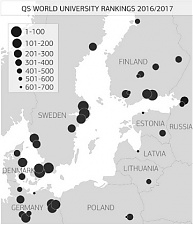Direct Speech, Education and Science, EU – Baltic States, Rating, Society
International Internet Magazine. Baltic States news & analytics
Thursday, 25.04.2024, 03:17
Baltic Rim universities: excellence, economic growth and future challenges
 Print version
Print version |
|---|
Early days of universities saw them as places of religious,
legal or medical professional training, gradually this mission was replaced by spreading
political or ideological influence and further, starting from the 19th century, universities were
increasingly seen also as institutions of nation building. Since the 80s of the
last century, in addition to the growing public demand for higher education,
there is a widespread belief that universities act as engines of economic
growth and regional development and thus last decades saw a great number of
smaller regional colleges emerge. As of today Baltic universities number in
hundreds among global 20-25 thousand and the global numbers are still growing.
Growth in quantity and increased (international) mobility of students has been
accompanied by questions about academic quality and increasingly also
excellence of our academic institutions and globalization has raised these
issues in a truly global perspective. How do Baltic rim universities stand in
these comparisons and were they are heading?
By large we may conclude that strong academic traditions together with national social and economic policies have resulted in extremely competitive universities. The most cited ranking, that of Quacquarelli-Symonds (topuniverities.com), has rated thousands of institutions and ranked 916 of them – that constitutes roughly 5% of all world universities. True, Baltic universities do not rank in top 10 or even top 50 since these places are taken mainly by US-UK institutions largely due to their global outreach and English being the post-second-world-war lingua franca of the academe. But further down the list we find altogether 30 Baltic universities in this “top 916 list” (we have not counted German and Polish institutions for they are more often related to the Central-European academic space rather than Nordic-Baltic, but we have involved Sankt-Petersburg University and SP Polytechnic University into this region (see Map). Most remarkably, and differently from most countries, these institutions cater for a large majority of the total student body in corresponding countries and therefore the overall academic standing of the Nordic-Baltic higher education is arguably most competitive, for in other regions top institutions represent a much smaller share of all institutions and therefore the average standing is more modest (remarkable exceptions being Switzerland, Israel and Singapore).
It is easy to see, that the ranked universities on the eastern coast of the Baltic Sea do not reach the best 300 but it is important to notice that less than ten years ago none of them were present in the global rankings. The academic progress after 50 years of forced separation from the global academic community has been nevertheless remarkable and some of them may well end up in the top 200 in the next decade. It is noteworthy, that there is a clear correlation between academic standing of universities and level economic development. More interestingly, this correlation is evident not only on the national, but also on the regional(!) level. Following the trends over the last few decades, we may observe the emergence of three regions of academic excellence – Öresund, Stockholm and Helsinki metropolitan areas. Differently from the European historic tradition of small university towns, away from business and trade, modern leading universities tend to grow in an economically thriving environment offering challenging partnerships and global outreach. In this context, it is understandable, that eastern coast institutions have to push for academic excellence together with their national economies and build local and regional partnerships for mutually beneficial advancement.
In this context, one may ask if universities first contribute
to economic growth or, vice versa, economic growth contributes directly to academic
advancement. Most probably, this relationship is a truly interrelated one and
we have to take this into account in order to avoid unfounded expectations and
related disappointments from misguided academic investments.
Furthermore, if the above said is true, the regional
economic environment is so important that strategic planning of universities
can not avoid taking these realities into account. Basically, it brings to a conclusion,
that academic ambitions of universities must be aligned to and coordinated with
the neighboring outside world much more strongly than usually accepted.
This, in turn, means that global rankings lose relevance for
universities outside of the global economic hotspot regions. This, however, does
not reduce their importance on the regional scale provided they define and
implement their academic mission in the corresponding
way.
The world of universities develops in circles – national
borders have disappeared in recent decades giving us a global pool of most diverse
institutions, which we have tried to rank one way or the other.
These rankings make sense in the case of global brands but
for the large majority of universities we have to pay much more attention to the
regional aspects and contexts developing also corresponding criteria for a
sensible comparison of different institutions.
Going this way we may well find, that some university
outside the established metropolitan areas, and not yet on the global ranking
list, turns out to be a real powerhouse.








 «The Baltic Course» Is Sold and Stays in Business!
«The Baltic Course» Is Sold and Stays in Business!

